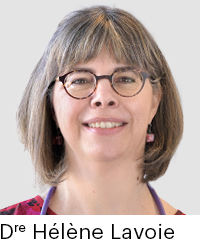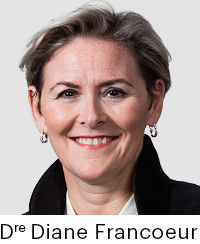
Despite accounting for half of humanity, women are over-represented when it comes to statistics on certain diseases and health problems. What's more, they are confronted with disorders that are unique to them, in a healthcare system that is not always able to recognize them.
About three out of four women will experience discomfort related to their menstrual cycle during their lifetime," Dr. Hélène Lavoie, a reproductive endocrinologist at the Centre hospitalier universitaire de Montréal, told the Insurance Portal. "This does not mean, however, that they suffer from premenstrual syndrome (PMS).
It takes an average of seven to eight years to get a firm diagnosis of endometriosis in Canada," Dr. Diane Francoeur, gynecologist and Executive Director of the Society of Obstetricians and Gynaecologists of Canada (SOGC), told the Insurance Portal.

That includes the time it takes to get an appointment with a doctor, then with a gynecologist, the wait for tests, then for results," she says. After that, you have to start the medication and find the right molecule, the right dosage. All the while, women continue to suffer.
The opposite is true of polycystic ovary syndrome (PCOS), which is over-diagnosed. About 25% of women have this multifollicular condition, but without the syndrome," says Dr. Lavoie. All three conditions (presence of follicles, irregular cycles and significant hair growth) must be met to diagnose it."
The COVID-19 pandemic meant that many women discovered they had the syndrome. “It's weight gain that increases male hormone production, and this is sometimes what reveals the syndrome,” explains Dr. Lavoie.
Main hormonal disorders
- Polycystic ovary syndrome (PCOS) is, according to the Canadian Medical Association Journal, a chronic disease characterized by irregular menstrual cycles, heavy hair growth and the presence of follicles on the ovaries, which have long been mistaken for cysts, hence the disorder's name. Untreated, PCOS can lead to infertility and miscarriage, as well as cardiovascular risks, mood disorders and excess weight, even obesity. It affects around 10% of women.
- Premenstrual syndrome (PMS) encompasses all the physical and psychological symptoms experienced by a person in the days leading up to menstruation, says the Merck Manual. These may include headaches, mood or sleep disturbances, bloating, fatigue, breast tension or abdominal cramps. Premenstrual Dysphoric Disorder (PMDD) occurs when the intensity of symptoms interferes with the sufferer's ability to carry out normal daily activities.
- Endometriosis is a chronic disease affecting at least 10% of women in Canada, according to the Endometriosis Network Canada. The disease is characterized by the development of uterine tissue that grows “abnormally in other areas of the body”, causing intense pain that can interfere with sufferers' daily activities. While its causes are unknown, research indicates that heredity may increase the chances of suffering from it. Endometriosis is generally treated by laparoscopy or hormone therapy.
- Menopause occurs on average between the ages of 45 and 55 although younger people may experience early menopause naturally or as a result of treatment, notably following cancer. It occurs with a significant drop in estrogen production, leading to a variety of symptoms, including hot flushes, fatigue, insomnia and mood disorders, among others. Three out of four people going through menopause experience symptoms “that interfere with their daily lives”, notes the Menopause Foundation of Canada.
The silent epidemic
For a long time, women's hormonal diseases and disorders were considered a “silent epidemic,” because there were few resources to help sufferers, and they didn't dare talk about their pain.
“These problems have always existed," says Dr. Francoeur. “It's just that more and more of them are being diagnosed. And it's far from benign. When you think about it, women spend 25% of their lives in poor health."
The lack of knowledge of symptoms among people likely to be living with a hormonal disease or disorder is also something to consider.
The misinformation circulating on social networks, in addition to the unattainable models found there, contributes to establishing, in many women, a sense of guilt and helplessness that has no reason to exist," emphasizes Dr. Francoeur.
“We tell them that their bodies should allow them to get through anything, that they should be able to do anything," she laments. “They're made to believe that when they're sick, their body has abandoned them, that it's a punishment. So women remain very discreet about it."
Many sufferers have a reflex not to talk about their reality, for fear of being judged, misunderstood or penalized because their symptoms bother them.
Added to this are the mental health issues that arise from their situation. In the United States, one study showed that it costs over six billion dollars a year to treat the mood disorders and psychological distress of PCOS patients. Such estimates are not available for Canada.
Scientific progress
The taboos surrounding female hormonal diseases and disorders are gradually disappearing, says Dr. Francoeur.
“Above all, there are new treatments and new ways of making a diagnosis,” she explains. When I started practicing, the only way to diagnose endometriosis was through surgery, a laparoscopy, to see the lesions."
“Now there are much more reliable modern methods,” she continues. With dynamic ultrasound, we're able to see endometriosis and lesions without surgery. It's a game-changer."
And further diagnostic progress is on the horizon. “It's still at the stage of research protocols, but eventually blood tests or oral swabs will be able to detect endometriosis,” she said.
Dr. Francoeur would like to see Canada follow the example of Australia, where hormonal disorders are treated on an outpatient basis in multidisciplinary clinics.
Endometriosis, chronic pelvic pain and everything else is managed there by sexologists, nutritionists, gynecologists, kinesiologists and many other specialists," she points out. There's a whole adaptation, a reprogramming, and the results are really very encouraging."
Exercises, infiltrations, certain medications and support can be much more effective in treating the symptoms of hormonal disorders by tackling their causes, rather than simply camouflaging the pain temporarily with opiates.
When women don't have access to good treatment and are in constant pain, they are prescribed Dilaudid and it never stops," adds Dr. Francoeur. Unfortunately, chronic pain can lead to opiate dependence or depression.
For menopause, hormonal treatments are used widely. According to a report published by Manulife in October 2024, the use of hormone replacement therapy increased by 20.7% among women aged 45 to 65 in the period between 2020 and 2023. Manulife’s aggregate data, showed that 13.1% of women claimants, ages 45 and 65, made a claim for hormone replacement therapy in 2023.
Hormone replacement therapy (also known as menopausal hormone therapy) can help with menopausal symptoms, but a relatively small percentage of women between the ages of 45 and 65 are accessing these treatments. According to Manulife aggregate data, only 13.1% of women claimants between the ages of 45 and 65 made a claim for hormone replacement therapy in 2023.1
"Between 2021 and 2024, we had a 40% increase in the number of claims for hormone therapy for menopause. This is very significant and demonstrates the increased access," iA Financial Group told Insurance Portal.
“Only about 15% of women don't need them,” according to Dr. Francoeur.
An equivalent proportion of women, on the other hand, will never stop experiencing menopausal symptoms, says Dr. Lavoie. The average duration of symptoms generally varies between three and seven years.
Research progresses
To bring relief to women, funds are being invested in research and treatments.
In the fall of 2023, Health Canada invested $1.6 million from the Sexual and Reproductive Health Fund to support two research projects.
First, nearly $875,000 was awarded to the Endometriosis Network of Canada for the creation of educational resources to reduce the time it takes to diagnose endometriosis. By detecting this disease earlier, sufferers will be able to obtain care sooner.
Another amount, this time of around $800,000, was given to SOCG to develop further endometriosis-specific educational resources.
Funding was also used to support and create informative tools for under-served patient groups, namely members of First Nations communities, racialized people and members of the LGBTQ2+ community (lesbian, gay, bisexual, trans, queer, two-spirited people and those identifying with sexual or gender diversity).
